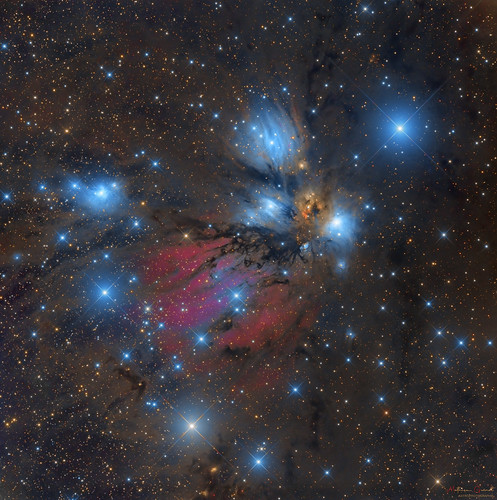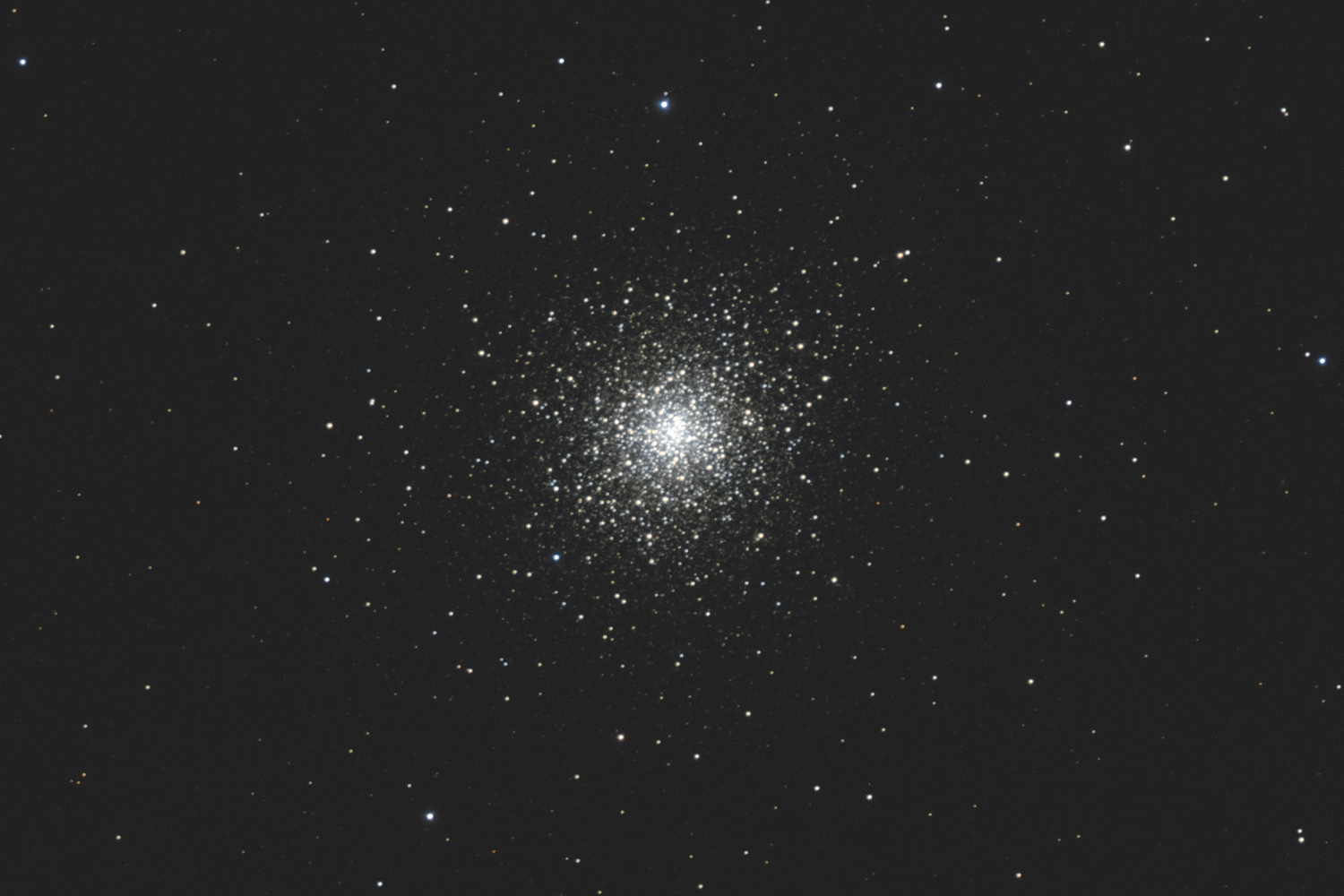Submissions: 2022 September
-
Frank A. Rodriguez
- Ensign
- Posts: 11
- Joined: Sun Feb 21, 2021 10:33 am
Re: Submissions: 2022 September
Reflection of the milky way over the ocean
http://www.instagram.com/astroeduca http://www.astroeduca.com
Copyright: Frank A. Rodriguez
Tasartico Beach. West of Gran Canaria Island. Canary Islands (Spain) Full Resol https://live.staticflickr.com/65535/523 ... a4be_k.jpg
http://www.instagram.com/astroeduca http://www.astroeduca.com
Copyright: Frank A. Rodriguez
Tasartico Beach. West of Gran Canaria Island. Canary Islands (Spain) Full Resol https://live.staticflickr.com/65535/523 ... a4be_k.jpg
-
martinkonrat
- Ensign
- Posts: 39
- Joined: Sun Sep 11, 2022 12:53 pm
Re: Submissions: 2022 September
 Cygnus Loop in narrowband OSC by Martin Konrat, no Flickr
Cygnus Loop in narrowband OSC by Martin Konrat, no FlickrCygnus Loop with Narroband OSC.
81 X 300s frames, totalizing a 6h45' integration.
🗓 September, 17th. 2022
🕶 Antlia 5mm ALP-T duo narrow band filter
Re: Submissions: 2022 September
Civilizations Icons
ISS trails Over the Great pyramid (15 Sep 2022, 18:58 Cairo time )
the great pyramid of Giza is one of the oldest wonders on the earth and it is considered a symbol of ancient civilization,
The ISS is one of the symbols of modern civilization and it was built using current knowledge and science, as the great pyramid contains the knowledge of ancient people.
From the past to the modern into the future
ISS rise from Southwest and got higher to Northwest from (18:58 to 19:02) around 4 mins then it went outside the frame, also you can find some star trails in the same period of ISS movement over the great pyramid
 Iss trails over the Great Pyramid by osama Fathi, on Flickr
Iss trails over the Great Pyramid by osama Fathi, on Flickr
Gears:
Nikon Z6 mod
Nikkor 14-24 mm
Settings:
trails: 33*5 sec, ISO 250, f3.5
Forground:1/80, ISO 640, f2.8
Software :
Sequator, Adobe Photoshop, Astrotools, Topaz DN
Credit :
Osama Fathi :
https://www.instagram.com/osama.fathi.nswatcher85/
https://www.facebook.com/NSWatcher/
Cairo, Egypt
ISS trails Over the Great pyramid (15 Sep 2022, 18:58 Cairo time )
the great pyramid of Giza is one of the oldest wonders on the earth and it is considered a symbol of ancient civilization,
The ISS is one of the symbols of modern civilization and it was built using current knowledge and science, as the great pyramid contains the knowledge of ancient people.
From the past to the modern into the future
ISS rise from Southwest and got higher to Northwest from (18:58 to 19:02) around 4 mins then it went outside the frame, also you can find some star trails in the same period of ISS movement over the great pyramid
 Iss trails over the Great Pyramid by osama Fathi, on Flickr
Iss trails over the Great Pyramid by osama Fathi, on FlickrGears:
Nikon Z6 mod
Nikkor 14-24 mm
Settings:
trails: 33*5 sec, ISO 250, f3.5
Forground:1/80, ISO 640, f2.8
Software :
Sequator, Adobe Photoshop, Astrotools, Topaz DN
Credit :
Osama Fathi :
https://www.instagram.com/osama.fathi.nswatcher85/
https://www.facebook.com/NSWatcher/
Cairo, Egypt
Re: Submissions: 2022 September
When I first started this project, I thought that the Dumbbell Nebula was going to be an easy one to process. I was looking to get the outer fringes (Ha/OIII) of the nebula to show up with some sort of detail. After an initial go with 40x300s on the Ha, I went back and captured 600s subs. That brought out the outer shell. Further processing of the LRGB data, I was able to get the white dwarf in the center to show itself. With a tad over 20 hours on this target, I can say that I am pleased with the outcome.
Target: M-27
Imaging Telescope: Explore Scientific ED127 CF
Imaging Camera: ZWO ASI2600MM-Pro
Guide Scope: Explore Scientific ED127 CF
Guide Camera: ZWO 290mm-Mini
Mount: Sky Watcher EQ8-R Pro
Polar Alignment: ASIAir Plus
Bortle Class: 6
Filter: Chroma 3nm & LRGB
39 x 600s (Ha)
40 x 300s (Ha)
40 x 300s (OIII)
40 x 300s (SII)
20 x 180s (L)
20 x 180s (R)
20 x 180s (G)
20 x 180s (B)
Integration: PixInsight
16 - 19 Sep 2022
Full Resolution: https://astrob.in/ultrlb/B/
Target: M-27
Imaging Telescope: Explore Scientific ED127 CF
Imaging Camera: ZWO ASI2600MM-Pro
Guide Scope: Explore Scientific ED127 CF
Guide Camera: ZWO 290mm-Mini
Mount: Sky Watcher EQ8-R Pro
Polar Alignment: ASIAir Plus
Bortle Class: 6
Filter: Chroma 3nm & LRGB
39 x 600s (Ha)
40 x 300s (Ha)
40 x 300s (OIII)
40 x 300s (SII)
20 x 180s (L)
20 x 180s (R)
20 x 180s (G)
20 x 180s (B)
Integration: PixInsight
16 - 19 Sep 2022
Full Resolution: https://astrob.in/ultrlb/B/
-
Victor Lima
- Ensign
- Posts: 70
- Joined: Tue Apr 21, 2020 11:38 am
Re: Submissions: 2022 September
CATEGORY: Panoramic Single Shot
SOCIAL IG: @victorlimaphoto
STORY:
The Iguaçu National Park is one of the most incredible places on the planet. The Iguaçu Falls add the largest set of waterfalls on the planet and were considered one of the 7 Natural Wonders of the World, in addition to being a Natural World Heritage Site by UNESCO.
In this image we can see in the sky the Magellanic Clouds and the structure of the Milky Way over the Iguazu Falls.
EXIF:
Canon 6Da | Sigma 20mm f/1.4 Art
16x 10 sec | f/1.8 | ISO 2500
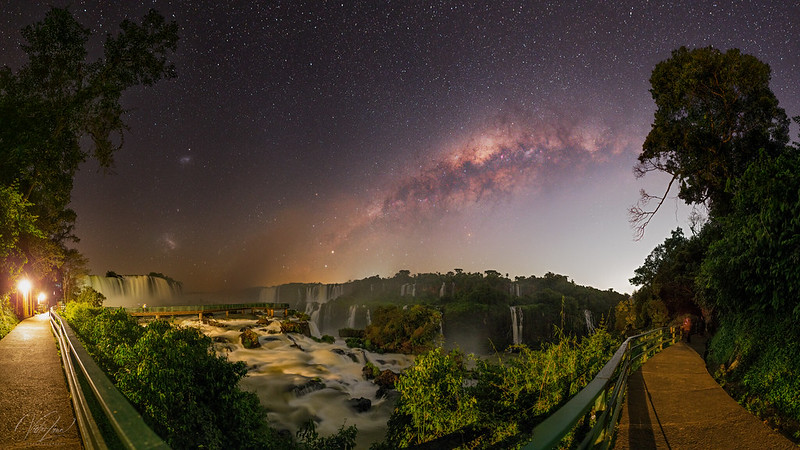 Iguassu Falls by Victor Lima, no Flickr
Iguassu Falls by Victor Lima, no Flickr
SOCIAL IG: @victorlimaphoto
STORY:
The Iguaçu National Park is one of the most incredible places on the planet. The Iguaçu Falls add the largest set of waterfalls on the planet and were considered one of the 7 Natural Wonders of the World, in addition to being a Natural World Heritage Site by UNESCO.
In this image we can see in the sky the Magellanic Clouds and the structure of the Milky Way over the Iguazu Falls.
EXIF:
Canon 6Da | Sigma 20mm f/1.4 Art
16x 10 sec | f/1.8 | ISO 2500
 Iguassu Falls by Victor Lima, no Flickr
Iguassu Falls by Victor Lima, no Flickr-
AndyWeller_UK
- Asternaut
- Posts: 1
- Joined: Sun Jul 18, 2021 10:06 pm
Re: Submissions: 2022 September
NGC 7331 - Deer Lick Group
Sometimes things go the way you want and i couldn't be happier with how this image of the NGC 7331 (Deerlick) group ended up looking. i've struggled with Galaxies on my set up. never being quite satisfied with the focus or the detail but on this ocassion it all seemed to come together.
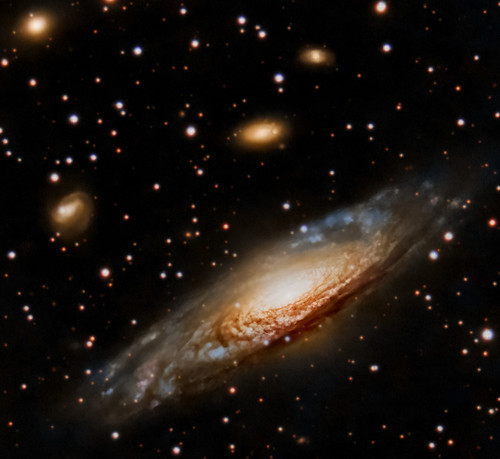
https://live.staticflickr.com/65535/523 ... f2fb_o.jpg
https://flic.kr/p/2nMRheR
I have included details of the imaging setup
Taken in Bedfordhire, England in a Bortle 5 area
Equipment used
Scope - Celestron C11 XLT reduced to F6.3
Camera - ZWO ASI294MC Pro
Filter - Optolong L-Pro
Guiding
Celestron OAG
ZWO ASI174MM Mini
Mount
Skywatcher EQ8-R Pro
Acquisition and guiding
ZWO ASIAIR Plus
Image Details
180No. 2 Minute exposures @ 180 Gain & -15C
60 Darks
60 Flats
60 FlatDarks
Stacked & Processed in Pixinsight
Sometimes things go the way you want and i couldn't be happier with how this image of the NGC 7331 (Deerlick) group ended up looking. i've struggled with Galaxies on my set up. never being quite satisfied with the focus or the detail but on this ocassion it all seemed to come together.

https://live.staticflickr.com/65535/523 ... f2fb_o.jpg
https://flic.kr/p/2nMRheR
I have included details of the imaging setup
Taken in Bedfordhire, England in a Bortle 5 area
Equipment used
Scope - Celestron C11 XLT reduced to F6.3
Camera - ZWO ASI294MC Pro
Filter - Optolong L-Pro
Guiding
Celestron OAG
ZWO ASI174MM Mini
Mount
Skywatcher EQ8-R Pro
Acquisition and guiding
ZWO ASIAIR Plus
Image Details
180No. 2 Minute exposures @ 180 Gain & -15C
60 Darks
60 Flats
60 FlatDarks
Stacked & Processed in Pixinsight
Last edited by AndyWeller_UK on Tue Sep 20, 2022 8:49 pm, edited 3 times in total.
-
martinkonrat
- Ensign
- Posts: 39
- Joined: Sun Sep 11, 2022 12:53 pm
Re: Submissions: 2022 September

Tarantula Nebula and Surroundings in the Large Magellanic Cloud, duo-narrowband OSC.
The nebula consists of a cloud of interstellar gas—principally hydrogen—lit from within by young,
hot stars that ionize the gas around them.
As the atoms in the gas recombine, they emit visible light.
The total mass of the nebula is about 1,000,000 solar masses, and its diameter is 170 parsecs (550 light-years),
making it the largest region of ionized gas in the entire Local Group of galaxies.
Tech info:
Giruá, RS, Brazil.
Bortle 4 zone.
Imaged between September 17 to 18th, 2022.
81 x 300s frames (6h45' total integration)
askar fma230 refractor
asi2600mc camera
Skywatcher AzGti mount - eq mode.
Antlia Duo-Narrowband 5nm ALP-T filter
Processing: Pixinsight, Photoshop.
Re: Submissions: 2022 September
Here's my take on Messier 78 in RGB. I plan on adding luminance as soon as it comes in. This was taken with the Telescope Live CHI-1 Planewave CDK24, FLI PL9000, and Astrodon RGB filters.
 M78_RGB by Scotty Bishop, on Flickr
M78_RGB by Scotty Bishop, on Flickr
More info on it found here: https://www.astrobin.com/qsjcwx/
 M78_RGB by Scotty Bishop, on Flickr
M78_RGB by Scotty Bishop, on FlickrMore info on it found here: https://www.astrobin.com/qsjcwx/
-
maxifalieres
- Ensign
- Posts: 22
- Joined: Fri Dec 18, 2020 6:39 pm
Re: Submissions: 2022 September
The NGC 6726, NGC 679 and the ngc 6723 In the Corona Australis Constellation.
Taken on the "Cielos Albertinos" Obeservatory - Alberti, Buenos Aires Province, Argentina.

NGC 6726, NGC 679 and NGC 6723
by Maximiliano Falieres, en Flickr
Taken on the "Cielos Albertinos" Obeservatory - Alberti, Buenos Aires Province, Argentina.

NGC 6726, NGC 679 and NGC 6723
by Maximiliano Falieres, en Flickr
-
maxifalieres
- Ensign
- Posts: 22
- Joined: Fri Dec 18, 2020 6:39 pm
Re: Submissions: 2022 September
The NGC 300 in Sculptor Constellation.
Taken on the "Cielos Albertinos" Obeservatory - Alberti, Buenos Aires Province, Argentina.

NGC253
by Maximiliano Falieres, en Flickr
Taken on the "Cielos Albertinos" Obeservatory - Alberti, Buenos Aires Province, Argentina.

NGC253
by Maximiliano Falieres, en Flickr
Re: Submissions: 2022 September
http://astronomiargb.webcindario.com/LO ... H2-136.jpg
SH2-136
LOS FANTASMAS DE CEFEO
R-27-5-2022
G-1-7-2022
B-27-5-2022
L-2-4-2022
TOMAS:
R: 23 Light de 600 segundos, 23 Darks, 31 Flats y 40 Bias
G: 30 Light de 600 segundos, 130Darks, 31 Flats y 40 Bias
B: 11 Light de 600 segundos, 11 Darks, 30 Flats y 40 Bias
L: 24 Light de 600 segundos, 24 Darks, 30 Flats y 40 Bias
que hacen un total de 14 horas 40minutos
TEMPERATURA: -10 GRADOS
TUBO:
FSQ 106 ED
CCD:
SBIG ST-8300M
MONTURA:
CGEM
CCD
guiar: QHY5 II
LUGAR:
LAS INVIERNAS (GUADALAJARA)
Un saludo
jose
SH2-136
LOS FANTASMAS DE CEFEO
R-27-5-2022
G-1-7-2022
B-27-5-2022
L-2-4-2022
TOMAS:
R: 23 Light de 600 segundos, 23 Darks, 31 Flats y 40 Bias
G: 30 Light de 600 segundos, 130Darks, 31 Flats y 40 Bias
B: 11 Light de 600 segundos, 11 Darks, 30 Flats y 40 Bias
L: 24 Light de 600 segundos, 24 Darks, 30 Flats y 40 Bias
que hacen un total de 14 horas 40minutos
TEMPERATURA: -10 GRADOS
TUBO:
FSQ 106 ED
CCD:
SBIG ST-8300M
MONTURA:
CGEM
CCD
guiar: QHY5 II
LUGAR:
LAS INVIERNAS (GUADALAJARA)
Un saludo
jose
Last edited by bystander on Wed Sep 21, 2022 8:11 pm, edited 1 time in total.
Reason: Please, no hot links to images > 500 kb.
Reason: Please, no hot links to images > 500 kb.
Re: Submissions: 2022 September
So, I couldn't find much info on this target in Stellarium, so I'm calling this the Ring nebula of Cygnus. Though I was told this target is called LDû 2, named after Pascal Le Dû who discovered it. There wasn't a whole lot of OIII, so did this one in the HSS color palette, along with RGB stars. Hope y'all enjoy!
Image Auther: Tommy Lease
Instagram Handle: colorado_astro
- ASI533MM-pro
Orion 8" f4 Newtonian
Antlia filters
EQ6R-Pro
Image Auther: Tommy Lease
Instagram Handle: colorado_astro
- Sergio
- Friendly Neighborhood Astrophotographer
- Posts: 100
- Joined: Mon Aug 29, 2011 5:26 pm
- Location: Buenos Aires, Argentina
- Contact:
Re: Submissions: 2022 September
NGC 6544 in Sagittarius
NGC 6544 is located in the western part of the constellation of Sagittarius, on the edge of a rich star field. Easy to find since is just 50' towards the southeast of the well known Lagoon Nebula. It can also be noted from dark skies with 10 x 50 mm binoculars as a small white spot like a misty star.
NGC 6544 was first observed by British astronomer William H erschel in 1784 who watched through his 18,4 inch reflector. He described as a fairly bright and large object circular and resolved into stars. As per today it is not clear whether it formed with the Milky Way or came from else ware.
More info at
www.baskies.com.ar
Best Regards
Sergio
NGC 6544 is located in the western part of the constellation of Sagittarius, on the edge of a rich star field. Easy to find since is just 50' towards the southeast of the well known Lagoon Nebula. It can also be noted from dark skies with 10 x 50 mm binoculars as a small white spot like a misty star.
NGC 6544 was first observed by British astronomer William H erschel in 1784 who watched through his 18,4 inch reflector. He described as a fairly bright and large object circular and resolved into stars. As per today it is not clear whether it formed with the Milky Way or came from else ware.
More info at
www.baskies.com.ar
Best Regards
Sergio
Re: Submissions: 2022 September
Mbube - The Lion
“In the jungle, the mighty jungle, the lion sleeps tonight.” – Written and recorded in 1939 by Solomon Linda and the Evening Birds
The Lion Nebula (Sh2-132) on the border of Cepheus and Lacerta. HOO (modified) with RGB stars.
Nick Pavelchak
https://www.astrobin.com/dck5z2/
“In the jungle, the mighty jungle, the lion sleeps tonight.” – Written and recorded in 1939 by Solomon Linda and the Evening Birds
The Lion Nebula (Sh2-132) on the border of Cepheus and Lacerta. HOO (modified) with RGB stars.
Nick Pavelchak
https://www.astrobin.com/dck5z2/
-
astrojoetography
- Asternaut
- Posts: 8
- Joined: Wed Sep 08, 2021 6:28 pm
Re: Submissions: 2022 September
This is part of the Cygnus region featuring the Tulip Nebula (Sharpless 101) and the Cygnus X-1 bow shock. Color palette is in HOO.
Image data collected in Michigan over July and August. This image represents ~45 hours of integration time at f/4.7.
Photographer: Joe Schlaf
@astrojoetography
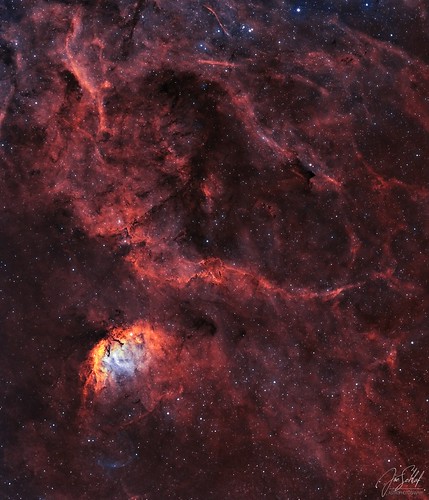 Tulip Nebula and Cygnus X-1 bow shock by Joe Schlaf, on Flickr
Tulip Nebula and Cygnus X-1 bow shock by Joe Schlaf, on Flickr
https://live.staticflickr.com/65535/523 ... 2d8c_k.jpg
Image data collected in Michigan over July and August. This image represents ~45 hours of integration time at f/4.7.
Photographer: Joe Schlaf
@astrojoetography
 Tulip Nebula and Cygnus X-1 bow shock by Joe Schlaf, on Flickr
Tulip Nebula and Cygnus X-1 bow shock by Joe Schlaf, on Flickrhttps://live.staticflickr.com/65535/523 ... 2d8c_k.jpg
Last edited by bystander on Thu Sep 22, 2022 1:23 pm, edited 1 time in total.
-
astrojoetography
- Asternaut
- Posts: 8
- Joined: Wed Sep 08, 2021 6:28 pm
Re: Submissions: 2022 September
This is the Omega Nebula (M17) -- and various other common names.
Image data collected in Michigan over June and July. This image represents ~41.5 hours of integration time at f/4.7.
Photographer: Joe Schlaf
@astrojoetography
 Omega Nebula by Joe Schlaf, on Flickr
Omega Nebula by Joe Schlaf, on Flickr
Image data collected in Michigan over June and July. This image represents ~41.5 hours of integration time at f/4.7.
Photographer: Joe Schlaf
@astrojoetography
 Omega Nebula by Joe Schlaf, on Flickr
Omega Nebula by Joe Schlaf, on FlickrRe: Submissions: 2022 September
Here is the Heart and Soul region with plenty of gas, some PNs, and all together a deep image at 104 hours total exposure in a mosaic.
This data is mostly from One Click Observations at Telescope Live, but also includes Advanced Request data as well.
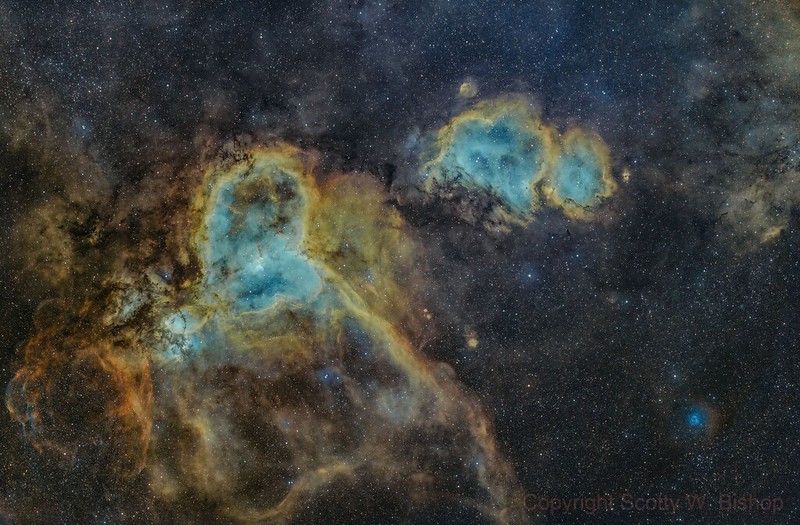 HS_SHO by Scotty Bishop, on Flickr
HS_SHO by Scotty Bishop, on Flickr
Full size is here and so are more details on it. https://www.astrobin.com/k7trgh/
This data is mostly from One Click Observations at Telescope Live, but also includes Advanced Request data as well.
 HS_SHO by Scotty Bishop, on Flickr
HS_SHO by Scotty Bishop, on FlickrFull size is here and so are more details on it. https://www.astrobin.com/k7trgh/
Re: Submissions: 2022 September
Hi Ann, I completed a zoom-in video of the Hubble Ultra Deep Field area, so here you can see where in the sky it is:Ann wrote: ↑Tue Sep 06, 2022 4:48 amThanks a lot!SkyViking wrote: ↑Tue Sep 06, 2022 4:23 amThank you very much Ann, I'm working on a video that zooms into the area on the sky and explores the Hubble Ultra Deep Field galaxies, in the meantime the coordinates for this image are RA: 3 32 39.046 Dec: -27 47 28.96Ann wrote: ↑Mon Sep 05, 2022 3:59 am Absolutely fantastic image, Rolf! I quite agree with you that I can indeed see the cosmic web here!
As always, I want to know "where in the sky" this is. "Fornax" is not enough of a clue. What are those two prominent galaxies at center left? What are their designations? If you don't know that, maybe you can tell me the designation of the bright orange star to the lower left of them (or, to the southeast of them, if north is up). And if you don't know the designation of the bright star either, then perhaps you can tell me the coordinates of the image, and maybe, maybe the coordinates of the two brightest galaxies?
Thanks a lot for your help! And thank you so much for this splendid image! Rarely has a "starless image" been such a good idea!
Ann
The two brightest galaxies are PGC 749724 and PGC 749439.
My software rejected the PGC designations, even though it does accept PGC galaxies. My software did show me two PGC galaxies nearby, PGC 12971 and PGC 12976, but they are 15th magnitude objects. Simbad Astronomical Database recognized PGC 749439 and called it a 17th magnitude active galactic nucleus, but it didn't recognize PGC 749724.
The coordinates that Simbad gave for PGC 749439 are RA: 03 33 20.6036338704 Dec: -27 49 10.267218948.
Ann
Zooming in on the Hubble Ultra Deep Field area in the Southern constellation of Fornax. Make sure to view in full screen and with the music turned up!
For a large annotated image with detected galaxies incl. magnitudes, red-shifts and corresponding distances, please visit
https://www.rolfolsenastrophotography.c ... /i-CC9Q5hV
Click to play embedded YouTube video.
-
lucam_astro
- Asternaut
- Posts: 9
- Joined: Sun Sep 01, 2019 3:10 am
Re: Submissions: 2022 September
The Lion Nebula (Sh2-132) and two bonus planetary nebulae
Sharpless 132 (Sh2-132) goes by the common name of the Lion Nebula and it straddles the boundary of the constellations Cepheus and Lacerta. It is primarily an emission nebula with several embedded small dark nebulae and is estimated to be at a distance of roughly 10,000 light years from Earth. The core of Sh2-132 includes pillar-like structures, Bok globules and the characteristic oxygen-rich stripe through the head of the Lion.
In the large field of view presented here there are also two small planetary nebulae that are well resolved. They are labeled PK102-02.1 (Abell 79) on the lower left of the image and PN G101.5-00.6 on the right of the image. Abell 79 is a planetary nebula in Lacerta comprising an irregular and broadened oval-shaped ring from which faint oppositely-directed lobes emerge. The characteristic shape is responsible for its name of the 6 nebula. It was discovered in 1947 by Rudolf Minkowski but only classified as a planetary nebula by George Abell in his1955 catalog.
PN G101.5-00.6 is an oxygen-rich young planetary nebula included in the IPHAS catalog of new extended planetary nebulae. It has a bipolar shape with a second fainter arch extending South of the main lobe.
Takahashi FSQ106EDX4
AP Mach2
ZWO ASI6200MM Pro
Chroma 3nm Ha, OIII, SII and RGB filters
Acquisition with Sequence Generator Pro
SHO processing with RGB stars in Pixinsight
Total acquisition time: 29 hours
Astrobin link: https://astrob.in/vcsxt2/0/
Sharpless 132 (Sh2-132) goes by the common name of the Lion Nebula and it straddles the boundary of the constellations Cepheus and Lacerta. It is primarily an emission nebula with several embedded small dark nebulae and is estimated to be at a distance of roughly 10,000 light years from Earth. The core of Sh2-132 includes pillar-like structures, Bok globules and the characteristic oxygen-rich stripe through the head of the Lion.
In the large field of view presented here there are also two small planetary nebulae that are well resolved. They are labeled PK102-02.1 (Abell 79) on the lower left of the image and PN G101.5-00.6 on the right of the image. Abell 79 is a planetary nebula in Lacerta comprising an irregular and broadened oval-shaped ring from which faint oppositely-directed lobes emerge. The characteristic shape is responsible for its name of the 6 nebula. It was discovered in 1947 by Rudolf Minkowski but only classified as a planetary nebula by George Abell in his1955 catalog.
PN G101.5-00.6 is an oxygen-rich young planetary nebula included in the IPHAS catalog of new extended planetary nebulae. It has a bipolar shape with a second fainter arch extending South of the main lobe.
Takahashi FSQ106EDX4
AP Mach2
ZWO ASI6200MM Pro
Chroma 3nm Ha, OIII, SII and RGB filters
Acquisition with Sequence Generator Pro
SHO processing with RGB stars in Pixinsight
Total acquisition time: 29 hours
Astrobin link: https://astrob.in/vcsxt2/0/
Re: Submissions: 2022 September
The North America and Pelican Nebulae in SHO
Astobin: https://www.astrobin.com/tnxabx/
Instagram: https://www.instagram.com/colorado_astro/
Equipment:
ASI2600MM-Pro
Antlia 36mm 3nm SHO filters
WO Redcat 51
HEQ5-Pro
Image Details:
Ha-115x300s, gain 100, -10c
OIII- 50x300s, gain 100, -10c
SII- 50x300s, gain 100, -10c
Total integration: 18 hrs
Bortle 5 sky
Acquired in NINA, Processed in Pixinsight and Photoshop
Instagram: https://www.instagram.com/colorado_astro/
Equipment:
ASI2600MM-Pro
Antlia 36mm 3nm SHO filters
WO Redcat 51
HEQ5-Pro
Image Details:
Ha-115x300s, gain 100, -10c
OIII- 50x300s, gain 100, -10c
SII- 50x300s, gain 100, -10c
Total integration: 18 hrs
Bortle 5 sky
Acquired in NINA, Processed in Pixinsight and Photoshop
Re: Submissions: 2022 September
Globular Cluster M 92 in Herkules, photographed from Switzerland
https://sternklar.ch/images-webpages/Fo ... Aug-22.htm
M 92 in Herkules, often overlooked due to M 13.
Exposure data:
Takahashi TOA 150/1100 APO-Refractor @ f/7.2, Canon EOS Ra, Exposure time 30 x 2 min (60 minutes total) and 10 Micron GM 2000 QCI Ultraportable Mount, August 23, 2022. Copyright: Manuel Jung, www.sternklar.ch
https://sternklar.ch/images-webpages/Fo ... Aug-22.htm
M 92 in Herkules, often overlooked due to M 13.
Exposure data:
Takahashi TOA 150/1100 APO-Refractor @ f/7.2, Canon EOS Ra, Exposure time 30 x 2 min (60 minutes total) and 10 Micron GM 2000 QCI Ultraportable Mount, August 23, 2022. Copyright: Manuel Jung, www.sternklar.ch
From the Swan to the Eagle
From the Swan to the Eagle - 28 shots at 300 seconds each shot from my backyard with a ZWO ASI2600MC camera, William Optics GT81 telescope, and Losmandy GM811G equatorial mount taken on Sept. 23rd, 2022.
-
barretosmed
- Science Officer
- Posts: 482
- Joined: Thu Oct 12, 2017 6:04 pm
Re: Submissions: 2022 September
IRREGULAR DWARF GALAXY - IC 1613
IC 1613, is an irregular dwarf galaxy, 2.3 million light-years away, in the constellation of the Whale.
This little-photographed galaxy belongs to the Local Group, a collection of more than 50 galaxies that includes our galaxy, the Milky Way.
BEST DETAILS:
https://www.astrobin.com/full/1f6llw/B/
EQUIPMENT:
Espirit 150mm triplet
Zwo asi 6200mc
Mount CEM120
137x300"
LOCATION: Munhoz - MG - Brazil
DATES: 07/01/2022 to 08/10/2022
Author: Fernando Oliveira de Menezes
(Organizing author of the book Amateur Astrophotography in Brazil)
https://clubedeautores.com.br/livro/ast ... -no-brasil
IC 1613, is an irregular dwarf galaxy, 2.3 million light-years away, in the constellation of the Whale.
This little-photographed galaxy belongs to the Local Group, a collection of more than 50 galaxies that includes our galaxy, the Milky Way.
BEST DETAILS:
https://www.astrobin.com/full/1f6llw/B/
EQUIPMENT:
Espirit 150mm triplet
Zwo asi 6200mc
Mount CEM120
137x300"
LOCATION: Munhoz - MG - Brazil
DATES: 07/01/2022 to 08/10/2022
Author: Fernando Oliveira de Menezes
(Organizing author of the book Amateur Astrophotography in Brazil)
https://clubedeautores.com.br/livro/ast ... -no-brasil
-
martinkonrat
- Ensign
- Posts: 39
- Joined: Sun Sep 11, 2022 12:53 pm
Re: Submissions: 2022 September

Orion Nebula, The Horsehead Nebula, and surroungings
This region, like possibly many of you, is the reason why I started photographing the night sky.
One and a half years ago I took my first poor, noisy and undefined picture of this region, that was my
first astrophotography. Since then I never took the time and had the courage to try it again due to the fear of
a new frustration. Today I am proud of my result and so I share it with you.
Nebulae are clouds of dust and gas that represent either end or the beginning of a star’s life cycle.
Some are places where stars have died, others where stars are forming. The Orion Nebula is the latter.
At only 1,344 light-years away, in Orion (the Hunter) constelation, the Orion Nebula is the closest and one of the brightest nebulae
visible from Earth. This means it can be seen with the naked eye up to mid-March when viewed under
dark skies.
The Horsehead nebula is a dark nebula composed of interstellar dust that blocks starlight
as well as the ionized gasses which comprise IC434
(the bright red emission nebula that is the backdrop of the Horsehead Nebula).
The Flame Nebula on the left is a reflection nebula that is lit
by nearby Alnitak (one of Orion's three belt stars).
Technichal Info
66 x 120s frames for a total of 2h12' integration time.
🗓 September, 23rd. 2022
🕶 IDAS LPS-P3 filter

